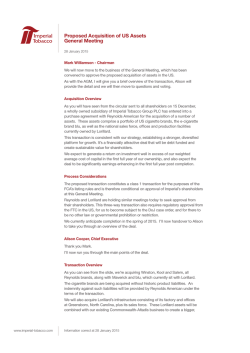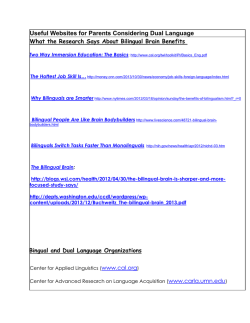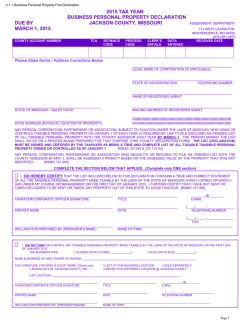
Language Development - Romani Early Years Network – REYN
Language Development in Young Children Objectives • To examine different theories of first language development. • To explain the importance of interactions and input in the development of first language(s). • To identify the steps a young child goes through in acquiring his/her first language(s). • To analyze how interactions and input are also important in second language acquisition. • To identify where different emotions can affect a person’s sequential language acquisition and to propose ways to work with them. The Story of My Name • Pick a partner and decide who will speak first and second • First speaker tells the story of his/her name for 3 minutes. • Second speaker speaks 3 minutes. Large group • Briefly introduce your partner and why their name is important to them. • Introduce where you work and where you are from. The Story of My Name • • • • • Who chose your name? When was it chosen? Were any other names considered? Are there any other people in your family with the same name? Do you know anyone else with the same name? Do you share your name with any famous people? Is your name unique? • What are your feelings concerning sharing (or not sharing) a name with someone else? • Have you always been called the same name? What other names have you been called? By whom? When? • What are your feelings about your name? Have they changed through time? In what ways? The Story of My Name Questions: • How was listening for you? • How was speaking for you? • What did learn about names? Extension Activities with Names • Children write books about names –interviewing family members • Parents write books about their children’s names • Write a Book About Naming Traditions What is language? • • • • • Language is uniquely human Language is linked to cognition Language is natural Language is culturally bound Language has many varieties and is constantly changing. What is language? Language has structure • Phonology (sounds) • Morphology (structure of words) • Syntax (structure of sentences) • Semantics (structure of meaning) • Pragmatics (rules and conventions of language) How do we learn language? • Behaviorists believe that children learn by imitating what they have heard and that parental modeling and reinforcement are the major promoters of language acquisition. • Nativists believe that innate, biological mechanisms are responsible for language acquisition (Chomsky, 1976 – language acquisition device) and that children just naturally acquire language with minor feedback from the social environment. How do we learn language? • Interactionists acknowledge both the child’s role and that of the caretaker in the social environment and consider the communication in social interactions to be essential to language acquisition. The process of language acquisition is both a personal and social invention. Parents, teachers, and others shape its development by the way they respond to the language learner. • We speak differently to young children than to other adults. We adapt our language. Interactionism Social constructivism: Vygotsky viewed cognitive development as the result of dialogue and that the main purpose of language is social. We learn language through social processes. The Importance of Interactions We know that interactions are important in all development including early language development. Video: Serve and Return Interaction Shape Brain Circuitry at http://developingchild.harvard.edu/resources/multimedia/v ideos/three_core_concepts/serve_and_return/ The Importance of Interactions Infants begin life with brain systems that allow them to acquire any and all languages to which they are exposed. The ability to make different sounds are pruned from their brains if they are not heard and supported in social interactions. The language adults use with infants and very young children known as ‘motherese,’ and is an example of interactionism and the value of social processes in language development. The Importance of Interactions Video: Watch the video, The Pyramid of Speech and Language Development that shows the building blocks of communication. https://www.youtube.com/watch?v=5Z0rvMbLP2o Discussion Question: How do very early interactions that infants have with caregivers build the foundation for speech development? The Importance of Interactions A child needs a strong foundation to get to the point where they are talking and using accurate speech in their first language(s). 5. Using accurate speech 4. Talking 3. Understanding of language (words, phrases, sentences) 2. Turn taking Eye contact Shared attention Listening 1. Opportunity/Reason/Motivation to Communicate Language as a Developmental Process • Babbling • One word • Two words • Short sentences The Four Stages in Acquiring Language https://www.youtube.com/watch?v=wxtLhgzntg8 Language Acquisition 1 https://www.youtube.com/watch?v=PZatrvNDOiE Language as a Developmental Process At approximately two years of age, children’s ability to use language suddenly increases rapidly. The size of their vocabulary grows and children begin to string words together in short sentences. Children are acquiring 6 to 10 words a day about the time they are entering preschool. They are also broadening their understanding of the meanings of the words they already know. Language as a Developmental Process Children also begin to acquire the more complicated grammar forms during this period. Their understanding of grammatical rules, however, can result in creative mistakes. These mistakes demonstrate that they notice consistent patterns in language and apply them to the language system, as they understand them. Language as a Developmental Process By the time children enter preschool, they have become experienced talkers and are engaged in an extended oral language development. This is because their caregivers have been encouraging them to extend their statements through talking with them. Children also augment their own language experiences by listening to others’ conversations in which they are not active participants. Simultaneous and Sequential Bilingualism Simultaneous acquisition of two languages occurs when children are exposed to both languages from a very early age, sometimes as a result of each parent speaking a separate language with the child or both parents speaking one language and a caregiver speaking another language with the child. If a child learns two languages simultaneously, and if the two languages are developed equally during childhood, then the language development process is expected to be the same in both languages. (Tabors, 2008) Simultaneous and Sequential Bilingualism Sequential acquisition occurs when a child begins to learn a second language after the first language is at least partly established, for example when a young child enters a preschool setting in which her home language is not the language used in the classroom. Simultaneous and Sequential Bilingualism Sequential language acquisition however is different: • Children already have some knowledge of how language works so they are not learning how language works in general but how the new language works and is different from the first language. Simultaneous and Sequential Bilingualism • The acquisition of the second language can take place at any age. • The acquisition of the second language may be more dependent on individual characteristics such as aptitude, personality (whether social or not), and psychological factors such as wanting to be like others. Krashen’s Hypothesis Stephen Krashen (1982) presented several hypothesis that today help us understand how children and adults learn new languages: • The Acquisition versus Learning Hypothesis. It states that new languages are actually best acquired in the same way that children acquire their first language(s) and not learned by formal teaching. Acquisition requires meaningful interactions in the new language in natural communication in which native speakers are focused on communication and not on form. Krashen’s Hypothesis • The Input Hypothesis: Learning to speak the new language requires meaningful input that is at the optimal level. It suggests that learners acquire language by “intaking” and understanding language that is a “little beyond” their current level of competence or “input + 1“. • zone of proximal development • scaffolds where possible. Krashen’s Hypothesis • The Affective Filter Hypothesis: Emotions such as anxiety can directly interfere or assist with in the learning of new language. Some emotions can create a kind of filter that blocks the learner’s ability to learn and use new words or grammatical structures because it can block the input that is needed. Krashen’s Hypothesis The three main things that can make the affective filter’s openings larger and allow more input in the new language to reach the leaner include that the learner have: • high motivation to learn the language, • have low anxiety levels, • high self-confidence in ability. Krashen’s Hypothesis Discussion: Give personal examples of what helped you or did not help you learn a new language by: • Increasing the level and quality of input you received in the new language. • Acquiring it in a natural way instead of learning new vocabulary and grammar rules. • Lowering or increasing your affective filter by lowering or increasing your anxiety, increasing or lowering your selfconfidence, or increasing or lowering your motivation to learn a new language. Developmental Phases in Acquiring Second Language 1. Home language use phase : There may be a period of time when children still use their first language. This is because they do not yet understand that there is difference in the 2 languages. 2. The silent or nonverbal period: When children discover that their home language does not work in the new setting, they enter into a nonverbal period as they collect information about the new language and perhaps spend some time in sound experimentation. In an officiallanguage classroom, this means that the children will enter a period when they do not talk at all. Developmental Phases in Acquiring Second Language 3. Going public with the new language: This is when children begin to use individual words and phrases that they have learned. Verbalizations such as “what is that?”, or reciting the names of colors, the alphabet, numbers, etc. or formulaic phrases in situations in which others have been observed to use them such as “yes, no, hello, goodbye, O.K., look, be careful,” etc. Developmental Phases in Acquiring Second Language 4. Productive Language Use in the New Language: This is when children can begin building their own sentences, not just continuing to repeat formulaic phrases or names for people and things. During this process the children must analyze the language being used around them and begin to make guesses about how the language is constructed. Typically, they use everything they already know about their new language, and, not surprisingly, make many mistakes as they work their way through the process of acquiring the more complicated aspects of second language. Developmental Phases in Acquiring Second Language For older children and adults the process is similar and looks like (Northwest Regional Educational Laboratory, 2003): • Silent/receptive or preproduction stage: This stage can last from 10 hours to six months. Students often have up to 500 “receptive” words (words they understand but may not be comfortable using) and can understand new words that are made comprehensible to them. This stage often involves a “silent period” during which students may not speak but can respond using a variety of strategies, including pointing to an object, picture, or person; performing an act, such as standing up or closing a door; gesturing or nodding; or responding with a simple “yes” or “no.” Developmental Phases in Acquiring Second Language • Early production stage: The early production stage can last an additional six months after the initial stage. Students have usually developed close to 1,000 receptive/active words (words they are able to understand and use). During this stage, students can usually speak in one- or two-word phrases and can demonstrate comprehension of new material by giving short answers to simple yes/no, either/or, or who/what/where questions. • Speech emergence stage: This stage can last up to another year. Students have usually developed approximately 3,000 words and can use short phrases and simple sentences to communicate. Students begin to use dialogue and can ask simple questions, such as “May I go to the restroom?” and are also able to answer simple questions. Students may produce longer sentences but often with grammatical errors that can interfere with their communication. Developmental Phases in Acquiring Second Language • Intermediate language proficiency stage: Individuals may need up to another year to reach intermediate proficiency after speech emergence. Students will have typically developed close to 6,000 words and can now make complex statements, state opinions, ask for clarification, share thoughts, and speak at greater length. • Advanced language proficiency stage: Gaining advanced proficiency in a second language can typically take from five to seven years. By this stage students have developed some specialized content-area vocabulary and can participate fully in grade-level classroom activities if given occasional extra support. Reflection Question: What phase of the process in acquiring a language that is not your first language are you? What would help you progress to the next level? Misconceptions on language development True or False: Bilingualism causes language delay. Misconceptions on language development Bilingualism causes language delay. • FALSE. While a bilingual child’s vocabulary in each individual language may be smaller than average, his total vocabulary (from both languages) will be at least the same size as a monolingual child. Bilingual children may say their first words slightly later than monolingual children, but still within the normal age range (between 8-15 months). And when bilingual children start to produce short sentences, they develop grammar along the same patterns and timelines as children learning one language. If a bilingual child demonstrates significant delays in language milestones, they could have a language disorder and should be seen by a speech language pathologist. Misconceptions on language development True or False: When children mix their languages it means that they are confused and having trouble becoming bilingual. Misconceptions on language development When children mix their languages it means that they are confused and having trouble becoming bilingual. • FALSE. When children use both languages within the same sentence or conversation, it is known as “code mixing” or “code switching”. Parents sometimes worry that this mixing is a sign of language delay or confusion. However, code mixing is a natural part of bilingualism. Proficient adult bilinguals code mix when they converse with other bilinguals, and it should be expected that bilingual children will code-mix when speaking with other bilinguals. Misconceptions on language development True or False: A person is not truly bilingual unless he is equally proficient in both languages. Misconceptions on language development A person is not truly bilingual unless he is equally proficient in both languages. • FALSE. It is rare to find an individual who is equally proficient in both languages. Most bilinguals have a “dominant language”, a language of greater proficiency. The dominant language is often influenced by the majority language of the society in which the individual lives. An individual’s dominant language can change with age, circumstance, education, social network, employment, and many other factors. Misconceptions on language development True or False: An individual must learn a second language as a young child in order to become bilingual. Misconceptions on language development An individual must learn a second language as a young child in order to become bilingual. • FALSE. There is a “Critical Period” theory that suggests that there is a window of time (early childhood) during which a second language is most easily learned. This theory has led many people to believe that it is better to learn a second language as a young child. Young children have been found to achieve better native-like pronunciation than older children or adult second language learners. And they seem to achieve better long-term grammatical skills than older learners. Misconceptions on language development True or False: If a family wants their child to speak the majority language, they should stop speaking their home language with their child. Misconceptions on language development If you want your child to speak the majority language, you should stop speaking your home language with your child. • FALSE. Some parents attempt to speak the majority language to their child because they want their child to learn that language, even if they themselves are not fluent in the majority language. This can mean that conversations and interactions do not feel natural or comfortable between parent and child. There is no evidence that frequent use of the second language in the home is essential for a child to learn a second language. Furthermore, without knowledge of a family’s home language, a child can become isolated from family members who only speak the home language. Research shows that children who have a strong foundation in their home language more easily learn a second language. Children are also at great risk of losing their home language if it is not supported continually at home.
© Copyright 2025





